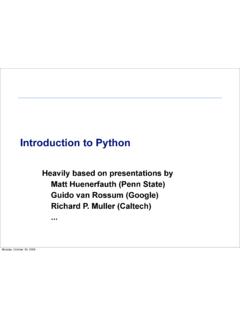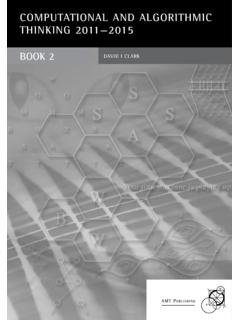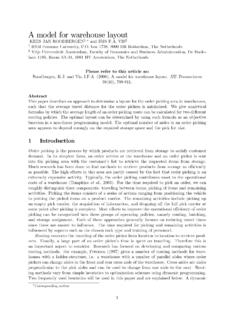Transcription of Logarithms Tutorial for Chemistry Students 1 Logarithms
1 Boston University CH102 - General ChemistrySpring 2012 Logarithms Tutorial for Chemistry Students1 What is a logarithm? Logarithms are the mathematical function that is used to represent the number (y) to which a base integer (a) israised in order to get the numberx:x=ay,wherey= loga(x). Most of you are familiar with the standard base-10 logarithm:y= log10(x),wherex= 10y. A logarithm for which the base is not specified (y= logx) is always considered to be a Easy LogarithmsThe simplest Logarithms to evaluate, which most of you will be able to determine by inspection, are those whereyis an integer value. Take the power of 10 s, for example:log10(10) = 1101= 10log10(100) = 2102= 100log10(1000) = 3103= 1000log10(10000) = 4104= 10000log10(1) = 0100= 1log10( ) = 110 1= ( ) = 210 2= ( ) = 310 3= ( ) = 410 4= Rules of Manipulating LogarithmsThere are four main algebraic rules used to manipulate Logarithms :Rule 1:Product Rulelogauv= logau+ logavRule 2:Quotient Rulelogauv= logau logavRule 3:Power Rulelogauv=vlogau1 Boston University CH102 - General ChemistrySpring 2012 Caution!
2 The most common errors come from Students mistakenly using twocompletely fictitiousrules (thereare no rules that even resemble these): loga(u+v)6= logau+ logav(logarithm of a sum) and logb(u v)6=logbu logbv(logarithm of a difference).The practical implication of these rules, as we will see in the chapters dealing with thermodynamics, equilibrium,and kinetics, is that we will be able to simplify complex algebraic expressions Approximating Numerical LogarithmsIn order to approximate the numerical values of non-trivial base-10 Logarithms we will need (a) a good understandingof the rules for manipulating Logarithms and (b) the values of log 2 and log 3, which are and , these values and the rules we learned above, we can easily construct a table for the log values of integersbetween 1 and 10 4 = log 22= 2 log 2 = 2( ) 10 = log 2 5 = log 2 + log 6 = log 2 3 = log 2 + log as (log 6 + log 8) 8 = log 23= 3 log 2 = 3( ) 9 = log 32= 2 log 3 = 2( )
3 DefinitionNotice that log 7 was determined using the approximation that it is the half-way point between log 6 and log general, as numbers become larger, the distance between their Logarithms becomes smaller. Consequently, thisapproach should work well for large numbers. A graphical representation of this table is:CH102 - Exam 2 Summer I, 2009 Useful information!H"mcs#!T$ccal#!T, NA" , 1 cal = J, 1 J = 1 kg m2!s2, 1 nm"103pm"1%10&9 m, 1 mL = 1 cm3, 1 m = 100 cm, !E"mcs#!T, 1 cal = J.!E"!mc2, !Elight"h', h" s, e" C, 1 eV" J, c" m/s, J = kg m2!s2, Nn""1!2#n#N0 1 Hz = 1/s, me" # "mu"h!(, u"'(, KE"p2)))))))))2#m"1))))2#mu2, PE"&Ze2))))))))))))))))4#*+0#r"&2#Z))))) ))))r# m, En"&Z2)))))))n2# "& #eV#Z2)))))))n2, En"h2#n2)))))))))))))))8# " !mol,me" , J"kg m2!s2, nm"10&9#m"10#!"1000# table and figure below are of values of log10"x# versus x.
4 Recall that ln"x#" #log10"x#.xlog10"x#xlog10"x# of log10(x) for 1,x, "x#Values of log10(x) for 1,x, Exam 1, Monday, February 9, 20097 Copyright 2009 Dan Dill All rights reserved32 Boston University CH102 - General ChemistrySpring 2012 The same approach can be used for numbers larger than ten (or smaller than one). Let s outline a generalapproach while solving for log If the number is a decimal, express the number as a whole number times 10 to a = log(36 10 4)2. Apply the product and power rules to separate the power of ten term and evaluate (36 10 4)= log 36 + ( 4) log 10 = log 36 43. Express the remaining number (36) as a product of prime 36 4 = log (4 9) 4 = log(2232) 44. Apply the product and power rules to separate all of the factors and use the table for log 1 to log 10 to (2232) 4 = 2 log 2 + 2 log 3 4 = 2( ) + 2( ) 4 = actual value2of log is : Approximating the value of log( 10 5)Following the same steps as above:log( 10 5)= log(22 10 6)= log 22 + ( 6) log 10= log (2 11) 6= log 2 + log 11 6= + 6= (Exact = ) Here, log 11 was computed by taking the average of log 10 (= ) and log 12 (= ).
5 Exercises:1. Approximate, numerically, the value of the following Logarithms :(a) log (b) log (c) log (d) log 810(e) log (f) log (g) log 10 2(h) log 10 5(i) log 103(j) log (k) log 10 5(l) log 75(1/3)2. Use your scientific calculator to compute the precise value of the above Logarithms . If there are any significantdiscrepancies, try them again! This exercise can be repeated, using any random numbers, until you feelcomfortable computing Logarithms by may run into a prime factor that is greater than 7. If that is the case, use the same approach we used to solve log 7 to solvethe logarithm of that prime using a Texas Instruments scientific calculator3 Boston University CH102 - General ChemistrySpring Natural LogarithmsNatural Logarithms are a specific subset of the general logarithm (x=aloga(x)), where the base (a) is the numbere(=.)
6 The natural logarithm is formally defined by:x=eln(x),where ln(x) (= logex) is the natural log of x .To compute natural Logarithms we can employ the following simple identity: ln(x) = log(x).Example: Approximating the value of ln( 10 5)Following the same steps as above:ln( 10 5)= log( 10 5)= ( )= (Exact = ) Here, log( 10 5)was taken from the exercise in the previous :1. Approximate, numerically, the value of the following Logarithms :(a) ln (b) ln (c) ln (d) ln 210(e) ln (f) ln (g) ln 10 3(h) ln 10 7(i) ln 102(j) ln (k) ln 10 4(l) ln 25(1/4)2. Use your scientific calculator to compute the precise value of the above Logarithms . If there are any significantdiscrepancies, try them again! This exercise can be repeated, using any random numbers, until you feelcomfortable computing Logarithms by AntilogarithmsThe antilogarithm, or power, function effectively undoes a logarithm.
7 The best example of this in Chemistry is tocompute the hydronium ion concentration from the pH. In this case,pH = log[H3O+],and the hydronium ion concentration can be found from the pH using:[H3O+] = 10 Approximating Base-10 AntilogsConsider the antilog of The procedure for computing the power, 10 , is as follows:1. Rewrite the power as ten to the power of the difference of two numbers: a number between 0 and 1, and 34 Boston University CH102 - General ChemistrySpring 20122. Separate the terms using the identity 10a+b= 3= 10 33. Use the definition of a base-10 logarithm (x= 10y) to determine the value ofx. The easiest way to do this isto use the logarithm graph (or table) from section In this case, 10 3 7 10 3 Example: Approximating the value of 10 the same steps as above:10 5= 5 2 10 5(Exact = 10 5)Here, approximated as 2 from the graph in section :1.
8 Approximate, numerically, the value of the following antilogs to 1 significant figure:(a) (b) (c) (d) 10 (e) 10 (f) 10 Use your scientific calculator to compute the precise value of the above Logarithms . If there are any significantdiscrepancies, try them again! This exercise can be repeated, using any random numbers, until you feelcomfortable computing Logarithms by





